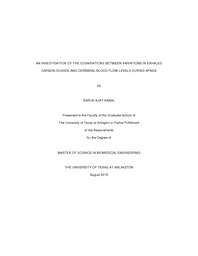
ATTENTION: The works hosted here are being migrated to a new repository that will consolidate resources, improve discoverability, and better show UTA's research impact on the global community. We will update authors as the migration progresses. Please see MavMatrix for more information.
Show simple item record
| dc.contributor.author | Kanal, Varun Ajay | en_US |
| dc.date.accessioned | 2015-12-11T23:20:11Z | |
| dc.date.available | 2015-12-11T23:20:11Z | |
| dc.date.submitted | January 2015 | en_US |
| dc.identifier.other | DISS-13336 | en_US |
| dc.identifier.uri | http://hdl.handle.net/10106/25396 | |
| dc.description.abstract | Sleep apnea is a breathing disorder characterized by repetitive reduction or cessation of breathing during sleep. It is estimated that that around 17% of adults suffer from mild to severe sleep disordered breathing. The aim of this study was to investigate the level of correlation between variations in exhaled CO2 and cerebral blood flow (CBF) during apnea. It is difficult to measure the CBF during sleep. This relationship was found in an effort to substitute the measurement of the changes in CBF with the changes in the CO2. The relationship between these two physiological parameters was first studied in healthy subjects. Two protocols were devised to examine the effect of posture – sitting versus supine – and frequency of apnea on the relationship between the variations in the two parameters: protocol A and B. The time between the two breath holds for protocol A was 90 s and for protocol B was 30 s. The two protocols were considered to study the cumulative change in the physiological signals due to successive apneas have on the relationship between the exhaled CO2 and CBF. End tidal CO2 (ETCO2) – peak of exhaled CO2 after apnea – and change in ETCO2 (Delta ETCO2) – difference in post apneic ETCO2 and the peak of exhaled CO2 in the baseline – was measured from the capnogram. From the cerebral blood flow recording, 11 metrics were computed: slope, Del1, PR1, Del2, PR2, Del3, PR3, oDel2, oPR2, PRArea and Norm Area. Slope is defined as the slope of the trend of the systolic points. Del1 is the change in the systolic value with respect to the baseline. PR1 is the percentage rise of the change defined by Del1. Del3 is the change in the systolic value from the normal breathing before the apnea. oDel2 is the change in the systolic value from the minimum of first 4 systolic point in the apnea. PRArea is the percentage rise in area under the CBF wave. Norm Area is normalized area under the systolic points with respect to 35 seconds in the baseline. We quantified the correlation between the metrics derived from exhaled CO2 and CBF using Kendall’s Rank and Spearman’s Rank order correlation methods. Spearman’s method indicated that in the supine position under protocol A, Norm Area had a correlation coefficient of 0.66 with Delta ETCO2 (p=2x10-3). It also had the highest correlation with ETCO2 correlation coefficient of 0.56(p=1.01x10-2). The same method also showed that in the supine position under protocol B, PR1 had the highest correlation with ETCO2 of -0.6 (p=1.63x10-4) and Norm Area had a correlation coefficient of 0.67 with Delta ETCO2 (p=7.96x10-7). Between the protocols the means of Del3 were statistically greater in protocol A (greater by (Δ)=7.21 cm/sec p=2.78x10-2) in the supine position. Between the postures the means of the following metrics were statistically greater in the supine position in protocol A; Norm Area (Δ=0.33 p=2.14 x10-2); Del3 (Δ=9.24 cm/sec p=5.07 x10-3); oDel2 (Δ=9.3 cm/sec p=4.5 x10-3); slope (Δ=0.41 cm/sec2 p=4.23 x10-4); Del1 (Δ=10.7 cm/sec p=2.38 x10-3). The means of the following metrics were statistically greater in the supine position in protocol B; Norm Area (Δ=0.36 p=1.6 x10-2); Del3 (Δ=6.06 cm/sec p=3.85 x10-2); oDel2 (Δ=5.97 cm/sec p=4.2 x10-4). The means of Delta ETCO2 were statistically greater in the sitting position (Δ=2.99 mmHg p=3.29x10-2) in protocol A. In the second part of this research, the relationship between exhaled CO2 and CBF in sleep apnea patients was investigated during sleep. In this study using both Kendall and Spearman’s methods none of the CBF and CO2 metric pairs, which had a significant correlation had a correlation coefficient greater than 50%. From the results of this study we can conclude that the proposed CBF CO2 metric pairs did not exhibit strong correlation to allow estimation of CBF via the changes in the exhaled CO2. | en_US |
| dc.description.sponsorship | Behbehani, Khosrow | en_US |
| dc.language.iso | en | en_US |
| dc.publisher | Biomedical Engineering | en_US |
| dc.title | An Investigation Of The Covariations Between Variations In Exhaled Carbon Dioxide And Cerebral Blood Flow Levels During Apnea | en_US |
| dc.type | M.S. | en_US |
| dc.contributor.committeeChair | Behbehani, Khosrow | en_US |
| dc.degree.department | Biomedical Engineering | en_US |
| dc.degree.discipline | Biomedical Engineering | en_US |
| dc.degree.grantor | University of Texas at Arlington | en_US |
| dc.degree.level | masters | en_US |
| dc.degree.name | M.S. | en_US |
Files in this item
- Name:
- Kanal_uta_2502M_13336.pdf
- Size:
- 2.973Mb
- Format:
- PDF
This item appears in the following Collection(s)
Show simple item record


